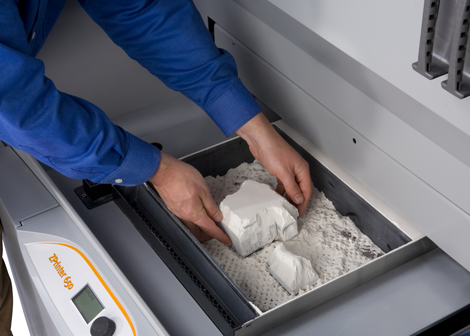
The Z Corp machines remove the initial large quantity of unused powder under negative pressure.
3D Printing has been through something of a boom of late, to say the least; it seems that you can’t even pick up a copy of the Economist without finding yourself presented with an image of the future.
That is a future, as the hyperbole seems to indicate, where we’ll be downloading 3D geometry from the web (probably for free, IP rights be damned) and printing out the products we need. Or at least, uploading them to a service provider in the medium time-frame.
There’s a new invigoration in interest in the 3D printing world with the entry of a wide range of low-cost machines from a variety of vendors. One thing that often comes up is the sustainable nature of the process.
After all, the idea of producing a part as and when it’s needed is incredibly attractive.
If it’s local printed, then all the better. But let’s not get carried away with ourselves. Many 3D printing technologies are incredibly wasteful. Those that require supports require that the supports are broken away, washed or dissolved away – often into the water table.
Take the now defunct Solido machine: It built parts using laminations of plastic sheet into which each layer was cut with a roller blade. To extract the model you discarded all of the block in which you built the model. 3D Systems’ VFlash machine does much the same. Unless you stack out the build chamber you’re looking at a huge amount of waste.
In these terms, the processes that hold the most potential are those which rely on a powder-based process. Something I was reminded of in a recent blog post by Scott Harmon, Z Corporation‘s vice president of business development who posted about “What Does 3D Printing Have To Do With Sustainability?” – and I reproduce an extract here with its kind permission:
Rapid prototyping in general makes strong contributions to corporate sustainability.
Reducing waste represents one of the key objectives of most sustainability efforts. Smart companies are doing everything possible to reduce the amount of waste material generated throughout their supply chains.
Improving quality, reducing packaging and miniaturisation are all methods that companies use to reduce the waste they generate. Interestingly, architectural designers have created specific certifications to improve how architects approach challenges in sustainability.
Intelligent use of 3D printers to make prototypes and scale models reduces waste in many different ways. By pushing errors and changes earlier in the design cycle, prototypes and scale models reduce the waste streams caused by those errors.
When you catch an error in the prototype, you cut less steel and waste less plastic. In architecture for example, the savings are even more dramatic because the scale is so large. When you use prototypes and models to create better designs, you reduce the number of final products that get thrown in the trash.
However, despite the positive contributions that rapid prototyping systems make to corporate sustainability efforts, there are enormous differences in the waste streams created by these processes.
I have heard stories of companies whose RP systems generate more waste than printed part material, at enormous dollar costs. Support material, shaving uneven surfaces, dissolving chemicals, etc. contribute substantially to the total cost of prototyping. These systems generate significantly larger hidden costs as those waste streams get flushed down the drain.
Z Corporation obviously prides itself on having the most efficient 3D printers in the industry: no support structures, no cleaning material disposal, no disposable build platforms, no chemical waste water, recycles 100% of the build material.
Less waste today, better world tomorrow.
I think Z Corp has done itself something of a disservice with the post. The manner in which it recycles powder is pretty impressive and it can not only save waste, but can also reduce the cost of ownership.
Most of Z Corp’s models now include material extraction from the build chamber and that fed directly back into the feed mechanism for the next build.

The clean up station integrated into the machine’s chassis lets you remove the remaining material, again, which is fed back into the system for reuse.
Other powder-based 3D printing technologies can do this but there is usually a requirement for fresh powder to be mixed in with the recycled material. That fresh/recycled ratio can also vary between the powder uses. It reaches its nadir when you’re working with complex composite materials, particularly filled (glass or carbon) materials at very high temperatures.
Ironically, it’s these types of materials that could provide the key to the mass customisation/3d printing revolution.






